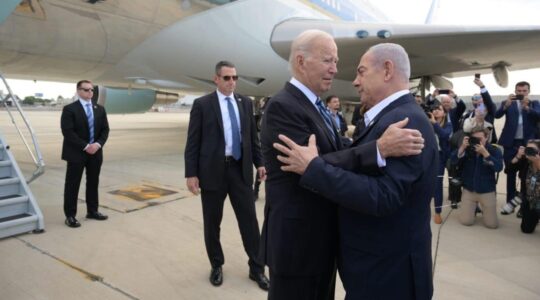JERUSALEM (JTA) – In their sixth major peacemaking effort since the unsuccessful 1991 Madrid peace conference, Israeli and Syrian negotiators face even tougher challenges than their failed predecessors.
All the old questions – borders, security arrangements, the nature of the peace, water, the timetable for implementation – are back on the table.
And two major obstacles have been added: the United States and Iran.
The United States, which would have to underwrite any agreement for Israel-Syria peace to be viable, for the first time is absent from the negotiating mix. Also, Syria’s ties with Iran, which would have to be downgraded significantly for Israel to sign an agreement, are much deeper than when the last Israel-Syria peace effort collapsed in March 2000.
Meanwhile, Israeli domestic opposition to a deal that entails withdrawal from the strategic Golan Heights remains as strong as ever.
So why should the parties succeed this time when past negotiations with ostensibly better opening conditions failed?
Obviously, given the obstacles, success is not guaranteed. But if there is a chance, it is because both sides now know exactly what the other’s needs are and can rely on the work done in previous rounds on the core issues.
Furthermore, because the geopolitical stakes are now much higher, each side has more to gain from a peace deal.
Israeli Prime Minister Ehud Olmert insists he gave the Syrians nothing to get them to agree to reopen the dialogue. That was one of Israel’s great achievements in the current process, he told the Knesset’s Foreign Affairs and Security Committee Monday.
But both the Turkish mediators and the Syrians suggest the prime minister reaffirmed the so-called Rabin “pocket,” or “deposit.” That was a promise that if Israel’s needs on security and the nature of peaceful ties are met, the Jewish state will withdraw to the pre-Six-Day War borders of June 4, 1967 – in other words, hand back the entire Golan Heights.
The border issue in fact was the main focus of the recent indirect Turkish-mediated talks between Israeli and Syrian representatives in Ankara. The Syrians described those exchanges as very encouraging and said they laid the basis for substantial progress.
But even if Olmert has reaffirmed the Rabin “pocket,” that does not mean the border issue has been settled – far from it.
One problem is it’s not clear where the 1967 border was because no such line was ever demarcated. After the 1949 armistice that ended the 1948 Israeli War of Independence, which itself was based on an earlier 1923 border between Syria and Palestine, the Syrians persistently encroached on no-man’s land, moving the border by their physical presence closer to Lake Kinneret.
In the last round of negotiations, in Shepherdstown, W. Va., and Geneva in January 2000 and March of that year, the Israelis suggested drawing a line to reflect where the Syrian armed forces were situated on June 4, 1967. The Syrians claimed that at some points they were just 33 feet from the water; Israel insisted on a line at least 1,300 feet from the lake.
The Israelis wanted to make it clear that they had full sovereignty over the Kinneret, Israel’s main source of water. Ultimately the talks collapsed over these differences, as Syria’s then-president, Hafez Assad, insisted in Geneva that the Kinneret was at least half Syrian.
The late Assad raised this claim out of the blue to scuttle a process in which he was no longer interested. It is unlikely that his son Bashar, the current Syrian leader, will repeat that tactic.
More likely, the parties will set up a joint border demarcation team, as they had planned to do at Shepherdstown. Indeed, the parties in West Virginia seemed very close to a deal on all the core issues.
On security, the outstanding difference was over an Israeli presence in a monitoring station on Mount Hermon. On normalization, the Israelis wanted ambassadors exchanged in the middle of the process, whereas the Syrians wanted it only at the end. On timetables, the Israelis wanted three years for implementation, the Syrians no more than 18 months.
It all seemed doable until Ehud Barak, Israel’s prime minister at the time, got cold feet. After a poll showing strong public opposition to returning the Golan, Barak slowed things down to give the impression that he was not giving away major assets easily. The Syrians felt he was backtracking and the talks collapsed.
Although Olmert and Bashar Assad seem ready to pick up the pieces, they find themselves facing very different regional realities.
Whereas Barak merely wanted Syrian help in establishing parallel peace talks with Lebanon, Olmert is insisting that Syria sever its ties with Iran. The Syrians reject this condition, even if the United States steps in to make good on any material and diplomatic losses Damascus might incur.
“Our ties with Iran are strategic and historic and can’t be sold in a bazaar,” Syria Information Minister Mohsen Bilal declared Sunday.
Israeli experts are divided over whether Syria is ready for a major reorientation – dropping ties with Iran, Hezbollah and Hamas – and in the context of a peace deal with Israel, coming over to the moderate pro-Western camp.
“Syria is ready to pay a huge price for its radical ideology and will never detach itself from Iran – certainly not now that the radicals seem to be getting stronger,” said Dan Shueftan, the head of Haifa University’s National Security Studies Center.
Shueftan says the Syrians simply are using Israel to ease international pressure on Damascus.
But Syria expert Moshe Maoz of Hebrew University argues that Assad sees two clear policy options, American and Iranian. He says Assad can be won over if the Americans offer a package that’s attractive enough.
The Americans, however, are not enthusiastic.
President Bush does not trust Assad nor, according to Israeli officials, does he believe there is much chance of the Syrian leader breaking with Iran.
Yet during his recent visit to Israel, Bush agreed to lift his long-standing opposition to any Israeli engagement with Assad’s Syria. Presumably, if the negotiations make progress and the United States needs to play a role, Bush or his successor in the Oval Office will be ready to make the necessary moves, given the huge geopolitical benefit of a pro-Western Syria.
For the embattled Olmert or his successor, getting the Syrians and the Americans on board for the type of region-changing agreement Israeli leaders envision will not be easy.
Achieving the domestic support they need might be even more difficult. Most of the Cabinet ministers in Olmert’s Kadima Party oppose a deal with Syria that entails withdrawing from the Golan, making a Cabinet majority for a deal nearly impossible.
Moreover, in the Knesset, Likud hawks are moving to enact a law requiring a special two-thirds majority for ceding land. Polls show that most of the Israeli public remains opposed to a withdrawal from the Golan, which Israel annexed in 1981.
The hope of Israel’s doves is that all this will change if and when Assad breaks with Iran and the United States comes through with strong backing for the new order. In other words, when Israelis see the results of peace with Syria, the Golan will seem a price worth paying.





